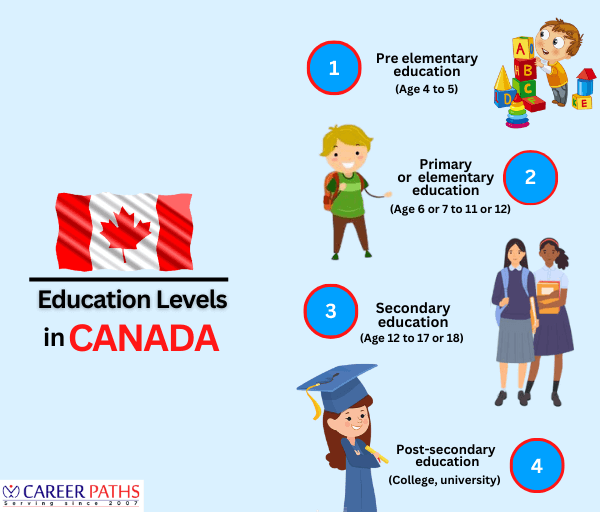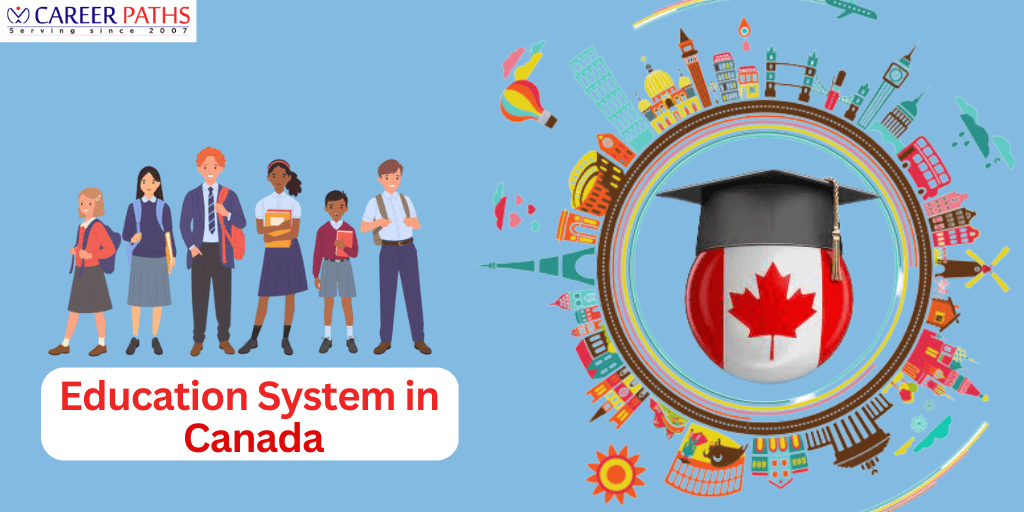Canada is the most well-desired country in the world for studying abroad, with more than a million international students intake per year. Canada is one of the best places in the world to experience cultural variety because of its large population of students and citizens from many foreign countries. The exposure to different cultures is one of the key reasons foreign students choose Canada as their destination of study.
The Canadian educational system is divided into four basic divisions: Pre elementary, Primary, Secondary, and Post-secondary education. In Canada, first-grade enrollment is mandated, which means a child must begin school at age 6. Tertiary education covers the degree programs and higher studies.
Canada is now home to students from over 135 countries, mostly from Asia, Europe, the Middle East, and Africa. It proudly competes with the USA, Germany, and the UK. In addition to the country’s other official languages, English is also regarded as an official language that benefits the country. There are numerous benefits for students to study at the undergraduate and graduate levels in Canada.
History of Education in Canada
Canada has a lengthy history of education. Canada’s education history includes the initial level of education to the highest one. Canada also has the theories of educators and the laws enacted by the federal and provincial governments.
In the early 17 century, religion was the subject that was studied all around Canada. However, in the mid 17 century, classical studies and theology was introduced. Education for females was rare during that time. Countryside women were privileged to get the light of education during that time. Those educated females later established different schools in towns as well as in the rural areas.
Egerton Ryerson, a minister, educator, and political figure in Canada in 1844, was regarded as one of the influential persons in developing Canadian education. Ryerson is known as the “father of public education in Ontario” as he worked as the Chief Superintendent of Education for Upper Canada for nearly 32 years. He came up with many new concepts of education after visiting different countries. He also planned to develop the public school system. During that time general people in Canada were highly influenced.
The School system was widespread in Canada during the start of the 19th century. By this time, there were so many obligations and obstacles that came in the way of development education in Canada. Many prominent personalities had to stop their calls for education due to the wars.
With the growing population and immigration, education in Canada developed profoundly and many leaders and intellectual persons were behind the success story of the development of education in Canada.
Education Levels in Canada
In Canada, each of the 10 provinces and 3 territories supervise education, and their respective ministries of education superintendent the standards of education. In Canada mostly schooling begins in September and ends in June. In all the Canadian public schools, the schooling is almost free for all.
There are mainly four levels of education in Canada. They are- Pre elementary, Primary education, Secondary education, and Post-secondary education.

Pre-elementary
Pre-elementary is the first stage of the education system in Canada. It is also known as the Kindergarten section. A child will stay in pre-elementary until starting his or her elementary at the age of 6 or 7. Canada’s all provinces have Kindergarten programs.
Elementary and pre-elementary schooling is almost free in all over Canada. However, private schooling will charge fees. Furthermore, if any international child wants to enroll in Canada for elementary and pre-elementary, then fees will be added in this case.
Primary education
Primary education is also known as the elementary education system in Canada. This level starts from Grade 1 to Grade 8. That means a child aged from six to seven has to start his or her schooling.
In Canada students have to start their education from grade 1 which starts at the ages of 6 or 7.
Primary education goes until grade 6 at the ages of 11 or 12 years old. At the elementary level, students are given special care so that the basics will be built strong.
Secondary education
Junior high school and high school are two parts of the secondary education system in Canada. Secondary education is also called secondary schooling in Canada. Secondary education starts from grade 9 to 12 in most of the provinces in Canada.
Students may continue on to college or university after successfully finishing high school at the age of 17 or 18. According to Canadian Law on education, students are not allowed to leave their schools or do further study until he or she crosses their 16s. The approximate cost for higher school is CAD 8,000 to CAD 14,000 per year.
Post-secondary education
Post-secondary education includes research, undergraduate universities. There are also vocational institutions available in Canada. Vocational colleges, career colleges, community colleges, institutes of technology or science, colleges of applied arts or applied technology etc are included in vocational institutions.
Language in Canada
International students are given the choice of studying in English, French, or both languages across the majority of Canada. While Studying or working in Canada, you can improve or learn English or French. You can also enroll in language classes to be ready to enroll in any Canadian university or college program or work.
International students in Canada
At all levels of the Canadian educational system, a notable number of international students are drawn to Canada. In terms of the best education system in the world, Canada is in the top 5. After the Covid-19 pandemic, the notion of studying abroad has become high. Canada is one of the best choices if you want to do higher studies abroad. The graph below is highlighting how fast the growth of international students is increasing in Canada.
Popular Universities in Canada
If you are an international student looking for a university to further your study, Canada can be a fantastic choice.
According to the World University Rank, the following universities are among the best.
| Universities | Location | QS World University Ranking (2023) | Average Tuition Fee (Per Year) |
|---|---|---|---|
| University of Toronto | Toronto | 34 | 12,698.98 CAD to 63,768.77 CAD |
| University of British Columbia | Vancouver | 47 | 58,803.42 CAD |
| McGill University | Montreal | 31 | 131,130 CAD to 67,128 CAD |
| McMaster University | Hamilton | 152 | 1,286.04 CAD to 1,796 CAD |
| University of Waterloo | Ontario | 154 | 16,886 CAD to 34,098.11 CAD |
| University of Alberta | Edmonton | 110 | 1,331.40 CAD to 4,945.20 CAD |
| University of Calgary | Calgary | 242 | 6,050 CAD to 7,750 CAD |
| University of Montreal | Montreal | =116 | 10,530 CAD to 28,677 CAD |
| Western University | Ontario | =172 | 55,658 CAD |
Popular Program in Canada
| Program | Available In | Approximate Course Duration | Approximate Tuition Fee |
|---|---|---|---|
| MBA | University of Alberta
University of Toronto McGill University |
2 Years, 5 Courses
2 Years, 4 Courses 1 Year, 5 Courses |
$40,221 to $48,414
$67,888 to $101,560 $82,500 to $99,500 |
| Computer Science & IT | University of Toronto
University of British Columbia |
Maximum 5 years
Maximum 5 years |
$80,000
$90,000 |
| Business & Finance | University of Toronto
University Canada West |
4 years
2 to 4 years |
$90,000
CAD 17,400 |
| Mathematics, Engineering, Architenture | University of Waterloo
University of British Columbia |
4 years
5 years |
$53,932 to $60,214
$69,496 to $142,945 |
| Media and Journalism | University of Toronto | 4 years | 230,000 CAD |
| Medicine, Biological Sciences, Biotechnology, and Pharmacy
|
University of Toronto
University of British Columbia McGill University |
4 Years
4 years 4 years |
CAD 118,000
$519,759 CAD 200,000 |
Canadian Online Degree
Since Canadian universities are renowned for their excellent standards, many people aspire to attend and graduate from this one. These days, realizing this desire is considerably simpler. Students who can’t commit to traveling and studying abroad might meet their urgent educational needs through distance learning. There are so many universities that offer online degrees for international students. Among so many we have listed down the top six universities that are best for online education in Canada.
Best Online Universities in Canada
| University name | Column 2 |
|---|---|
|
Athabasca, Alberta |
|
Sudbury, Ontario |
|
Kingston, Ontario |
|
Fredericton, New Brunswick |
|
Ontario |
|
Victoria, British Columbia |
Best Areas for International Students in Canada
Canada’s top cities for studying are Montreal, Toronto, Vancouver, and Ontario. Besides the top four, British Columbia, Alberta, Quebec, and Nova Scotia are also seen as popular amongst international students.
International students can find part-time jobs as well in these cities besides studying. Living in the cities is always best for international students. However, Ontario is preferable and the most well-liked province for international students. The most important cities; Toronto and Ottawa are in this province as a result half of the province’s population is mixed. Besides studying abroad, discovering new cultures, good work opportunities and beautiful environment are other benefits of studying in Canada.
Funding and Scholarships for international students in Canada
Although the chance to study in Canada is one that can change your life, top-notch higher education is not free. The majority of Canadian scholarships are available to international students for postgraduate programs. There is a fully funded scholarship available. However, undergraduate scholarships are not that much given as those programs are longer.
Career Building and Work Permit
The rules for work permits after graduation in Canada come through different new phases. According to new rules, one can apply for a post-graduation work permit (PGWP) after completing the study.
To complete the education, one must apply for a work permit visa through the (PGWP) Program. You have to open an express entry profile if you want Canadian permanent residency. To open an express entry profile your profile has to be strong enough and you have to be a skilled worker in Canada.
FAQs
At what age is education free in Canada?
Elementary and pre-elementary schooling is almost free in all over Canada.
Can a foreign child go to public school in Canada?
All international students are welcome to enroll in any Canadian elementary or secondary school.
Can someone with a tourist visa attend school in Canada?
If you have two permissions you can attend schools with a tourist visa. They are- a visitor record or a study permit.
How much time off do students in Canada get each year?
Christmas and March break both last for two weeks.
Final Words
International degrees are a hallmark of the Canadian educational system nowadays. Although the expense of living in Canada may seem a bit excessive to some students, it is worth it when you consider the whole accomplishment you will have after earning your degree.
The quality of Canadian education is always rising and improving. The increase in applicants to Canadian universities is primarily due to this.
Please leave a comment if you have any questions about the Canadian educational system.




